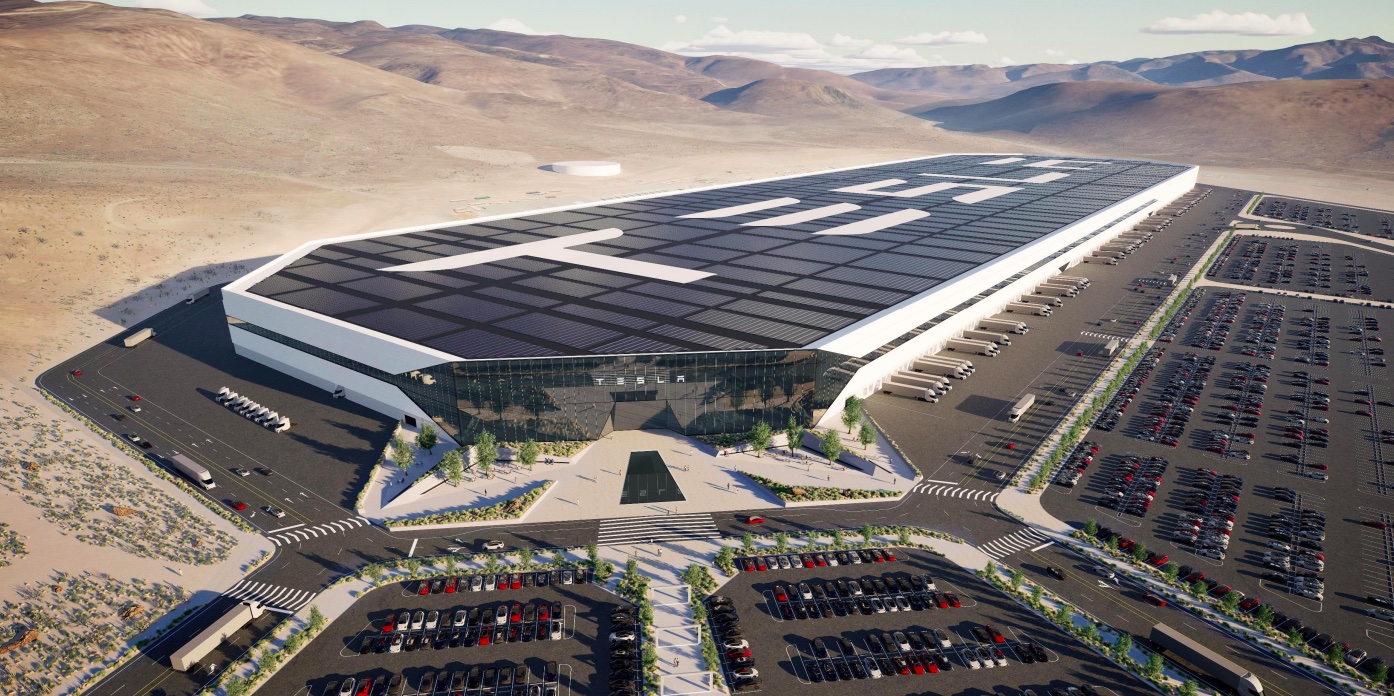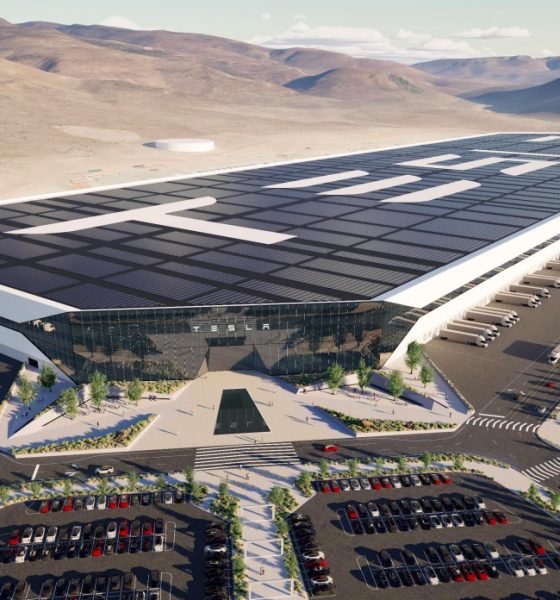

News
Tesla battery supplier Panasonic to increase battery production at Giga Nevada
Tesla battery supplier Panasonic is accelerating plans to increase battery cell production at Gigafactory Nevada. Increasing battery production at Giga Nevada would likely help Tesla increase its vehicle production capacity and benefit from the Inflation Reduction Act’s (IRA) electric vehicle (EV) tax credits.
An executive from Panasonic shared that Tesla approached the Asian battery supplier about battery supply. Tesla told Panasonic it would buy as many battery cells as Panasonic could make.
Tesla has made similar public statements in the past, emphasizing that its 4680 production lines would not disrupt any cell supply relations with other battery suppliers. Elon Musk and other Tesla executives have always been clear that the company would still buy battery cells from its partners, including LG Energy Solutions, Panasonic, and CATL in China.
In response to Tesla’s statement, Panasonic decided to install an additional production line at Gigafactory Nevada, sources told Nikkei Asia. The executive who shared information on the matter added that Giga Nevada is “already crammed,” explaining why only one battery cell production line is being added.
Potential Impact of Tesla and Panasonic’s Battery Production
The new cell production line is expected to begin operation in a year or two. It’s estimated to increase Tesla Giga Nevada’s annual production capacity by about 10% from 38 GWh to 39 GWh. At 39 GWh, Giga Nevada would produce enough battery cells for Tesla to manufacture between 500,000 to 700,000 Tesla Model 3 vehicles.
Tesla isn’t the only EV automaker investing in battery cell production. The Inflation Reduction Act’s EV credits for domestic cell production have encouraged more automakers and foreign battery suppliers to build battery plants in the United States.
In the Q4 2022 earnings call, Elon Musk commented that the IRA’s credits for domestic manufacturing could make significant contributions in the future.
“Long term, we expect these–the value of these credits to be very significant,” said Musk. “And in the case of Panasonic domestic manufacturing, we’re splitting the value of the credits. So it will–the value of credits this year will not be gigantic, but I think it could be gigantic.
Zack Kirkhorn shared a bit more about Tesla’s estimates regarding the IRA’s credits related to battery composition.
“So different products, we think, will get different amounts of credit. The regulations here are still in flux and there continues to be updates, so this is just our best understanding at the moment. But we think on the order of $150 million to $250 million per quarter this year and growing over the course of the year as our volumes grow,” Kirkhorn said.
Kirkhorn concluded that the IRA’s credits could eventually impact the affordability of some electric vehicles.
Panasonic’s Future in the United States
Besides Tesla, Panasonic might start working with Stellantis and BMW on new battery plants in North America. The Japanese battery supplier already selected Kansas as the site for a 4680 plant.
“We were concentrating on Kansas and developing the new [4680] battery, but the IRA turned the tide. Tesla started saying to prioritize batteries that we can quickly increase in quantity,” said the Panasonic executive.
Panasonic shifted its plans for the Kansas facility. It will produce 2170 battery cells in Kansas as well, along with 4680 cells. Sources state that the Asian battery supplier will focus on making 2170 cells in Kansas because they are “a few months faster to supply.”
The Teslarati team would appreciate hearing from you. If you have any tips, contact me at maria@teslarati.com or via Twitter @Writer_01001101.

News
Tesla FSD fleet is nearing 7 billion total miles, including 2.5 billion city miles
As can be seen on Tesla’s official FSD webpage, vehicles equipped with the system have now navigated over 6.99 billion miles.

Tesla’s Full Self-Driving (Supervised) fleet is closing in on almost 7 billion total miles driven, as per data posted by the company on its official FSD webpage.
These figures hint at the massive scale of data fueling Tesla’s rapid FSD improvements, which have been quite notable as of late.
FSD mileage milestones
As can be seen on Tesla’s official FSD webpage, vehicles equipped with the system have now navigated over 6.99 billion miles. Tesla owner and avid FSD tester Whole Mars Catalog also shared a screenshot indicating that from the nearly 7 billion miles traveled by the FSD fleet, more than 2.5 billion miles were driven inside cities.
City miles are particularly valuable for complex urban scenarios like unprotected turns, pedestrian interactions, and traffic lights. This is also the difference-maker for FSD, as only complex solutions, such as Waymo’s self-driving taxis, operate similarly on inner-city streets. And even then, incidents such as the San Francisco blackouts have proven challenging for sensor-rich vehicles like Waymos.
Tesla’s data edge
Tesla has a number of advantages in the autonomous vehicle sector, one of which is the size of its fleet and the number of vehicles training FSD on real-world roads. Tesla’s nearly 7 billion FSD miles then allow the company to roll out updates that make its vehicles behave like they are being driven by experienced drivers, even if they are operating on their own.
So notable are Tesla’s improvements to FSD that NVIDIA Director of Robotics Jim Fan, after experiencing FSD v14, noted that the system is the first AI that passes what he described as a “Physical Turing Test.”
“Despite knowing exactly how robot learning works, I still find it magical watching the steering wheel turn by itself. First it feels surreal, next it becomes routine. Then, like the smartphone, taking it away actively hurts. This is how humanity gets rewired and glued to god-like technologies,” Fan wrote in a post on X.
News
Tesla starts showing how FSD will change lives in Europe
Local officials tested the system on narrow country roads and were impressed by FSD’s smooth, human-like driving, with some calling the service a game-changer for everyday life in areas that are far from urban centers.

Tesla has launched Europe’s first public shuttle service using Full Self-Driving (Supervised) in the rural Eifelkreis Bitburg-Prüm region of Germany, demonstrating how the technology can restore independence and mobility for people who struggle with limited transport options.
Local officials tested the system on narrow country roads and were impressed by FSD’s smooth, human-like driving, with some calling the service a game-changer for everyday life in areas that are far from urban centers.
Officials see real impact on rural residents
Arzfeld Mayor Johannes Kuhl and District Administrator Andreas Kruppert personally tested the Tesla shuttle service. This allowed them to see just how well FSD navigated winding lanes and rural roads confidently. Kruppert said, “Autonomous driving sounds like science fiction to many, but we simply see here that it works totally well in rural regions too.” Kuhl, for his part, also noted that FSD “feels like a very experienced driver.”
The pilot complements the area’s “Citizen Bus” program, which provides on-demand rides for elderly residents who can no longer drive themselves. Tesla Europe shared a video of a demonstration of the service, highlighting how FSD gives people their freedom back, even in places where public transport is not as prevalent.
What the Ministry for Economic Affairs and Transport says
Rhineland-Palatinate’s Minister Daniela Schmitt supported the project, praising the collaboration that made this “first of its kind in Europe” possible. As per the ministry, the rural rollout for the service shows FSD’s potential beyond major cities, and it delivers tangible benefits like grocery runs, doctor visits, and social connections for isolated residents.
“Reliable and flexible mobility is especially vital in rural areas. With the launch of a shuttle service using self-driving vehicles (FSD supervised) by Tesla in the Eifelkreis Bitburg-Prüm, an innovative pilot project is now getting underway that complements local community bus services. It is the first project of its kind in Europe.
“The result is a real gain for rural mobility: greater accessibility, more flexibility and tangible benefits for everyday life. A strong signal for innovation, cooperation and future-oriented mobility beyond urban centers,” the ministry wrote in a LinkedIn post.
News
Tesla China quietly posts Robotaxi-related job listing
Tesla China is currently seeking a Low Voltage Electrical Engineer to work on circuit board design for the company’s autonomous vehicles.

Tesla has posted a new job listing in Shanghai explicitly tied to its Robotaxi program, fueling speculation that the company is preparing to launch its dedicated autonomous ride-hailing service in China.
As noted in the listing, Tesla China is currently seeking a Low Voltage Electrical Engineer to work on circuit board design for the company’s autonomous vehicles.
Robotaxi-specific role
The listing, which was shared on social media platform X by industry watcher @tslaming, suggested that Tesla China is looking to fill the role urgently. The job listing itself specifically mentions that the person hired for the role will be working on the Low Voltage Hardware team, which would design the circuit boards that would serve as the nervous system of the Robotaxi.
Key tasks for the role, as indicated in the job listing, include collaboration with PCB layout, firmware, mechanical, program management, and validation teams, among other responsibilities. The role is based in Shanghai.
China Robotaxi launch
China represents a massive potential market for robotaxis, with its dense urban centers and supportive policies in select cities. Tesla has limited permission to roll out FSD in the country, though despite this, its vehicles have been hailed as among the best in the market when it comes to autonomous features. So far, at least, it appears that China supports Tesla’s FSD and Robotaxi rollout.
This was hinted at in November, when Tesla brought the Cybercab to the 8th China International Import Expo (CIIE) in Shanghai, marking the first time that the autonomous two-seater was brought to the Asia-Pacific region. The vehicle, despite not having a release date in China, received a significant amount of interest among the event’s attendees.








